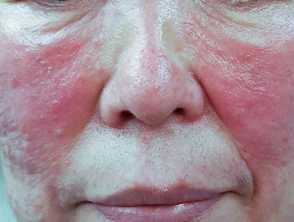- Case-Based Roundtable
- General Dermatology
- Eczema
- Chronic Hand Eczema
- Alopecia
- Aesthetics
- Vitiligo
- COVID-19
- Actinic Keratosis
- Precision Medicine and Biologics
- Rare Disease
- Wound Care
- Rosacea
- Psoriasis
- Psoriatic Arthritis
- Atopic Dermatitis
- Melasma
- NP and PA
- Skin Cancer
- Hidradenitis Suppurativa
- Drug Watch
- Pigmentary Disorders
- Acne
- Pediatric Dermatology
- Practice Management
- Prurigo Nodularis
- Buy-and-Bill
News
Article
Estrogen, Hormone Changes Play Role in Rosacea and Skin Alterations, Study Finds
Author(s):
The study explored the potential role of hormonal changes, specifically estrogen levels, in the pathogenesis of rosacea.
A recent study published in Skin Research and Technology delved into the correlation between perimenopause and the incidence and severity of rosacea in middle-aged women, exploring the potential role of hormonal changes, specifically estrogen levels, in the pathogenesis of rosacea.
The observational study, conducted at the dermatology outpatient department of West China Hospital, spanned from January 2022 to January 2023.
Fifty-nine perimenopausal women with rosacea were enrolled, meeting specific diagnostic and inclusion criteria. Dermatology Quality of Life Index (DLQI), Rosacea-specific Quality-of-Life instrument (RosQol), and the Hospital Anxiety and Depression Scale (HADS) were employed to assess patients' quality of life, anxiety, and depressive states, respectively. Blood samples were collected to measure estradiol (E2), follicle-stimulating hormone (FSH), and testosterone (T) levels.
The study revealed a significant impact of rosacea on the quality of life of perimenopausal women, with high rates of anxiety and depression.
Furthermore, the severity of ETR symptoms was associated with lower E2 levels, indicating a potential link between estrogen and rosacea. The "Estradiol Protective Hypothesis" gained support, suggesting estrogen's role in maintaining optimal skin physiology and protecting against dermatoses.
The study highlights the higher incidence and severity of rosacea in middle-aged women, particularly those in perimenopause. The correlation between hormonal changes and rosacea, with a focus on estrogen levels, suggests a route for understanding the pathogenesis of this dermatological condition. The study proposes that the decrease in estrogen during menopause may contribute to the higher prevalence of the ETR subtype in perimenopausal women.
Researchers acknowledged study limitations, such as a relatively small sample size and a focus solely on perimenopausal female patients. The exclusive consideration of estradiol leaves room for exploring other potential factors influencing rosacea.
Further research is needed to validate these findings across diverse demographics and consider additional contributing factors, study authors wrote.
"This study provides a novel idea and direction for the mechanism of estrogen in the pathogenesis of rosacea and the potential of estrogen regulation in the treatment of rosacea," wrote Yang et al.
Reference
Yang F, Wang L, Jiang X. Clinical characteristics of rosacea in perimenopausal women. Skin Res Technol. Published January 14, 2024. Accessed January 16, 2024. https://onlinelibrary.wiley.com/doi/10.1111/srt.13542
Newsletter
Like what you’re reading? Subscribe to Dermatology Times for weekly updates on therapies, innovations, and real-world practice tips.







